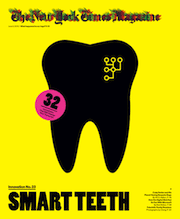Futurist Marketing: 5 Incredible Advances in Healthcare
 Consider this a brief continuing education exercise. Take a three-minute break from your work today and step into the not-too-distant future. Healthcare and medical marketing professionals…ask yourself, “How would I devise a marketing plan for any of theses five innovations in health?”
Consider this a brief continuing education exercise. Take a three-minute break from your work today and step into the not-too-distant future. Healthcare and medical marketing professionals…ask yourself, “How would I devise a marketing plan for any of theses five innovations in health?”
You may not have heard about these ideas, but The New York Times Magazine Annual Innovations Issue envisions an event horizon of two to four years from now…so best to be thinking ahead. Among the Times 32 Innovations That Will Change Your Tomorrow, here are five incredible advances in healthcare that you may be advertising soon:
#3 ANALYTICAL UNDIES (2 Years Away)
According to the Times article, “A Finnish company, Myontec, recently began marketing underwear embedded with electromyographic sensors that tell you how hard you’re working your quadriceps, hamstring and gluteus muscles. It then sends that data to a computer for analysis.” The same concept will reportedly transfer from performance athletes to everyday wear for sedentary office workers, and has potential for PT and rehab, pharmaceutical dosing and other applications.
#10 DOCTOR ON BOARD (4 Years Away)
Within a few years, Researchers at the University of Michigan International Center for Automotive Medicine expect that your car can predict the likely severity of injuries from a crash. “E.M.T.’s would know the likelihood of internal bleeding or traumatic head injury, for example, before arriving on the scene,” the Innovations Issue says, “which would help them decide whether to move you to a Level 1 trauma center or a standard emergency room.”
#23 TEETH THAT THINK (4 Years Away)
Dentist will love it when your teeth let you—and your dentist—know it’s time to make an appointment. (Seriously.) “Scientists at Princeton and Tufts are working on a superthin tooth sensor (a kind of temporary tattoo) that sends an alert when it detects bacteria associated with plaque buildup, cavities or infection.” Other healthcare applications for the same sensors, reports the Times, may be “to identify bacteria in saliva associated with stomach ulcers and cancers.”
#24 SLEEP MINING (2 Years Away)
NeuroVigil, Inc. is developing a brain analysis system—that uses neuroscience, non-invasive wireless brain recording technology and advanced computational algorithms—to read brain wave data. In simpler terms, “Wearing a small sensor on your head, at home, while you sleep, could be the key to diagnosing diseases early and assessing overall health.” The company envisions applications related to “autism, studying the efficacy of trial-phase drugs and assessing traumatic brain injury in soldiers.” A future version of the device will talk to a smartphone or tablet.
#25 A BLOOD TEST FOR DEPRESSION (4 Years Away)
Ridge Diagnostics is introducing what they describe as the first “objective biological test information about depression that may aid physicians in the differential diagnosis of Major Depressive Disorder (MDD), the selection of proper treatment and effective management of their patients.” The company’s test for MDD is based on their proprietary Human Biomarker Library and Biomarker Hyper-Mapping™ technology.
The road between invention and wide availability is quite often bumpy and long. And expecting that these examples of innovative science will reach the consumer in a matter of a few years just may be optimistic. Nevertheless the science behind these five examples seems real enough, and they might be found in healthcare marketing and advertising soon.
All “32 Innovations” reported by The New York Times Magazine—“an abridged guide to the many ways that your day is about to get better"—are available here.








